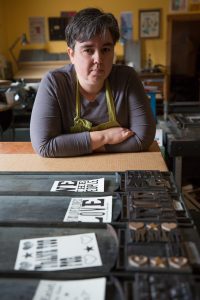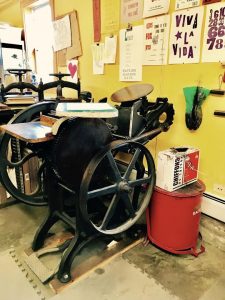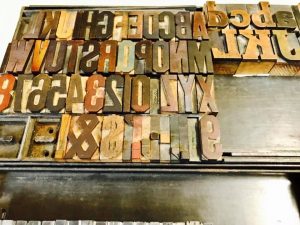Kelly McMahon is a one-time poet who walked into a print shop and never looked back. She has a BA in English Literature from Smith College, and an MFA in Creative Writing from California College of the Arts, where she spent (a little) time writing and (much more) learning the craft of letterpress. She now lives in Montpelier, Vermont, where she founded and runs May Day Studio, a letterpress purveyor of “quirky paper goods.”

As graduate students of the MFA program in Writing and Publishing here at VCFA, we are encouraged to find internships at literary or art-affiliated organizations. I knew I wanted to work with words in a tactile way, and May Day Studio offered an internship position that would give me the exact experience I was looking for. I had no background in letterpress work at all, but Kelly was immediately generous with her time and devoted herself to teaching me all she knew about the artform. Each week, I spend three wonderful hours in the one-room studio with her: engaging in everything from distributing and organizing typefaces (aka fonts) to packaging products for upcoming craft fairs to marbling paper. Kelly is perhaps the most organized person you will ever meet; she has a delicious taste in music (yes, I have heard her “KEXP Song of the Day” mixtapes more than once); and she creates an impressive range of paper goods that just beg customers to reach out and slide their hands over the many textures.
I am thrilled to share the conversation I had with Kelly about her childhood passions, poetry, and the infectious joy of letterpress art.
Cameron Finch: What were some of your passions when you were a child? What did you want to be “when you grew up?”
Kelly McMahon: I have always loved reading. Words and stories were and continue to be my escape from daily life. I thought that being a librarian would be the best job ever—I could read all day long!
CF: How did you get your start in letterpress printing? Do you remember a defining moment that drew you to this field?
KM: I took a seminar in graduate school called “Writing in the Book Structure.” It was an art school, so we had vague class assignments like “print something on the printing press” and “make a book.” I set my longest poem—over 30 lines—in (unbeknownst to me) a very worn font of type. The professor then showed me the brand new type and I reset the entire text. It was beautiful!
CF: Why does this form of artistic expression suit you?
KM: I get to practice perfection every day! Setting type, mixing ink, cutting paper, achieving perfect alignment of form and paper are all so deeply satisfying.
CF: That’s funny that you mention perfection! I remember one day during my internship at May Day, you shared that in college, you took a course called “Failure.” Could you tell us a little more about that class and how you implement its teachings into your work now?
KM: I took “Failure” my second semester of graduate school. The course had readings, films, and visual art components that explored the various ways in which we fail as humans, as artists, and what happens after. We had two main assignments: to fail privately and to fail in public. And to document it all. The class sessions were amazing (and overwhelming) explorations of what it means to be an artist, and how failure is not the opposite of success—but a step on the path.
CF: What led to the creation of May Day Studio in 2006?
KM: I finished graduate school in 2004 and was working two part-time jobs: at a retail paper/art shop and as a legal assistant. I was offered promotions at both jobs, and had to choose between a low-wage but creative job or a higher-wage but supremely boring job. I picked poor but creative, and here I am!
CF: What inspired the name “May Day Studio?”
KM: My birthday is May 1 (aka “May Day”). Folks assume it’s the distress call “mayday”—but I wouldn’t want to feel panicked every time I thought about my business!
CF: Can you describe your favorite press you use to make pieces on?
KM: They’re all my favorites! I love the rumble-rumble-click-click of Lucy, the Vandercook, and the way the paper slides smoothly out of my hand around the cylinder. I love the whoosh-clank of Butch, the Chandler & Price platen press, as the dog turns the ink disc. And Minnie, the little Chandler & Price Pilot, was my first press and does all the little jobs with no fuss.
CF: What tools of the trade can you not live without?
KM: Top three: my favorite mechanical pencil, a line gauge (aka a printer’s ruler), and my Pantone book of colors.
CF: Do you have a particular approach (or process) as you begin a project?
KM: I make lists! And more lists. Listing all the variables and options and costs helps me reduce a complex process down to its most elemental. And once the clutter is cleared, then I can get creative!
CF: Is there a project/piece you’ve worked on that you are especially proud to have made?
KM: I am so proud of the poetry broadsides I’ve designed and printed for “Poets Pulling Prints”—the poetry reading and broadside-printing event I’ve hosted at the studio for the last two years.
CF: You also are a poet and studied poetry in graduate school. What is your relationship to poetry now that you are a full-time letterpress artist?
KM: I take lots of notes! I write poems in the car, while I’m driving, and hope the words will still be there when I reach my destination. Someday I will find the time to write it all down again.

CF: How does your meticulous and precise process with the letterpress influence the way you write and compose your poetry? Have you found it has changed at all since your graduate school days?
KM: I am a word nerd, through and through. My word choices—and their sounds and meanings and histories and echoes—are very important. I think my recent notes/poems are more spare, less effusive. They are moments, rather than hours or days.
CF: Are there any particular themes you are drawn to write about in your poems?
KM: My theory of language is all about relationships—the words that bounce around my brain are related to, but not exactly the same, words that find their way out of my mouth, and once those words are in the air, they are heard/interpreted/reacted to by another brain. So much gets lost (and found?) in the movement. That’s really a long way of saying that I write about everything, but usually it just sounds like I’m writing about myself.
CF: Who are your artistic influences?
KM: That’s so hard for me to narrow down! Writers—Emily Dickinson. Sylvia Plath. Joan Didion. Virginia Woolf. Filmmaker—Sofia Coppola, for sure. Artists—Marc Chagall. Claude Cahun. Cindy Sherman. Joseph Cornell. And for a letterpress bonus: Jessica Spring and Chandler O’Leary, aka the Dead Feminists.
CF: Is there a book or a film that has changed you as a person?
KM: I keep coming back to my childhood favorite—A Wrinkle in Time. Meg Murry was my ultimate awkward-nerd hero.
CF: What’s next for May Day Studio? Any new products, events, or projects in the line-up?
KM: We’re heading into the busy holiday season right now—so I’ve got lots of craft fairs plus two pop-up holiday shops to stock with quirky holiday cards and gifts.
Stay up to date with Kelly’s latest products on May Day Studio’s website: http://www.maydaystudio.com.

